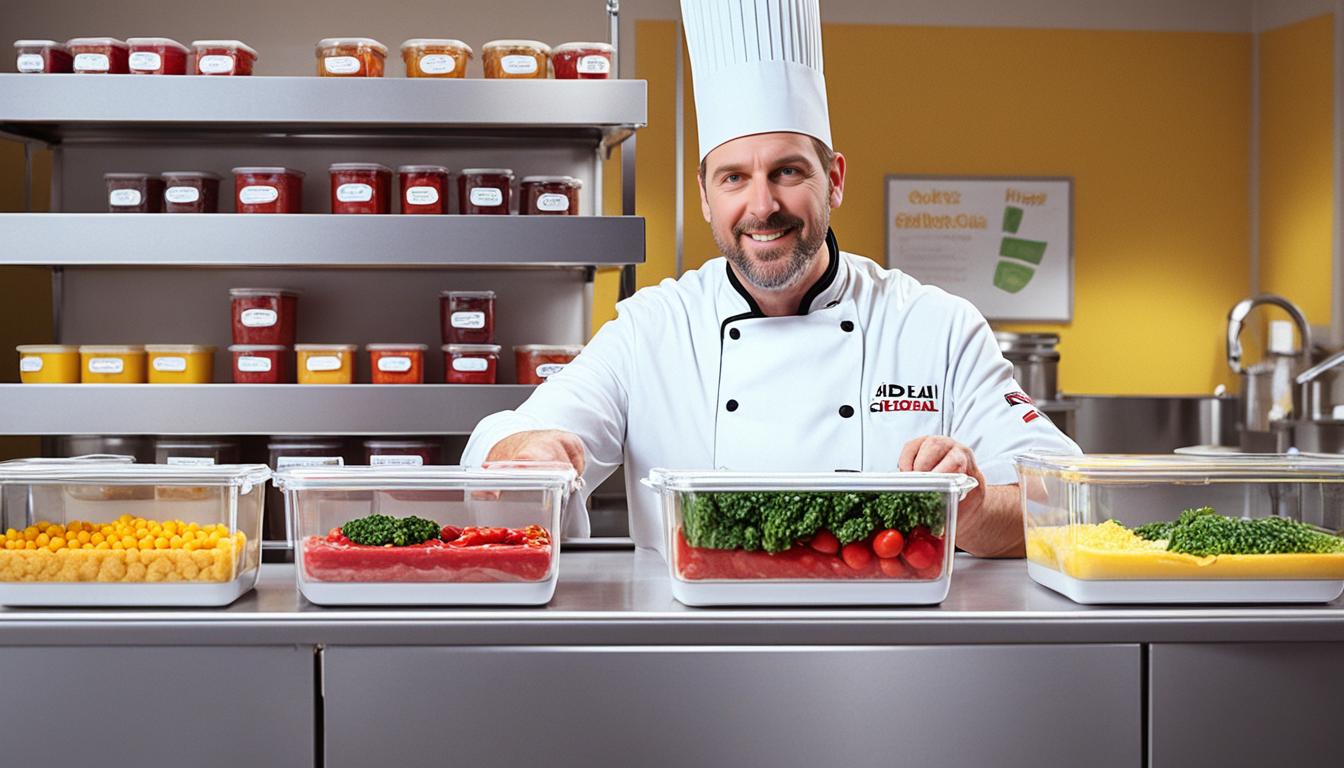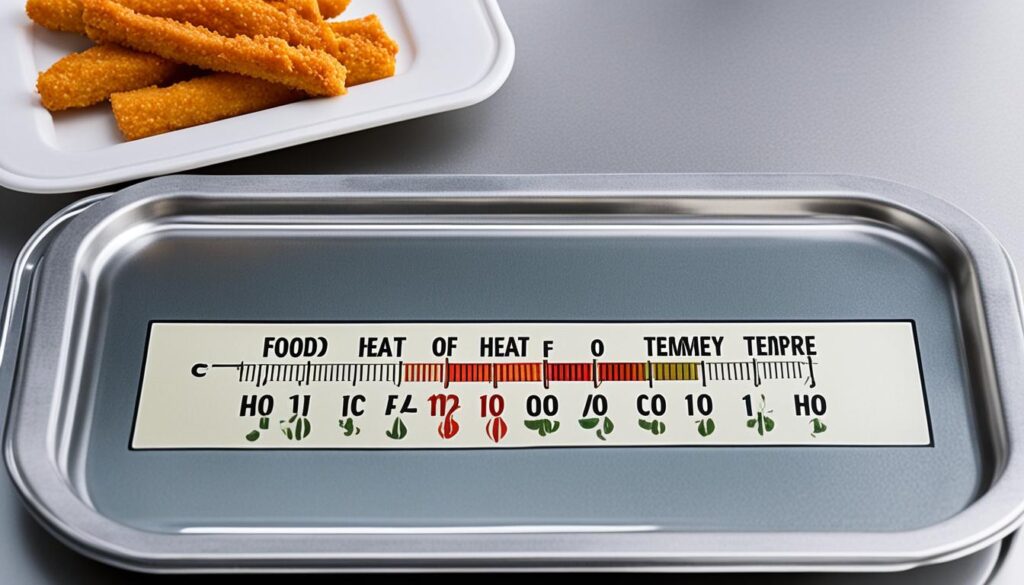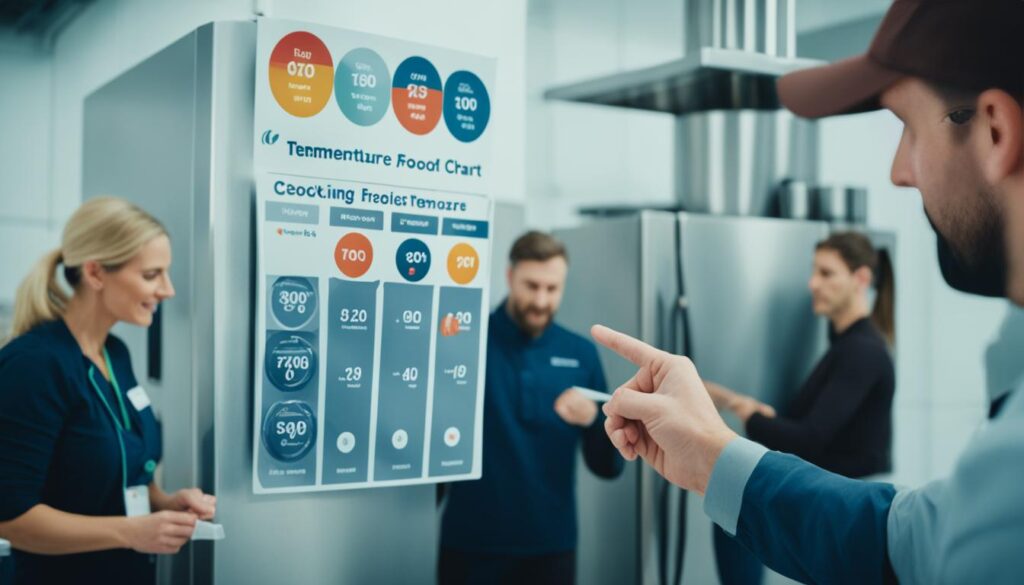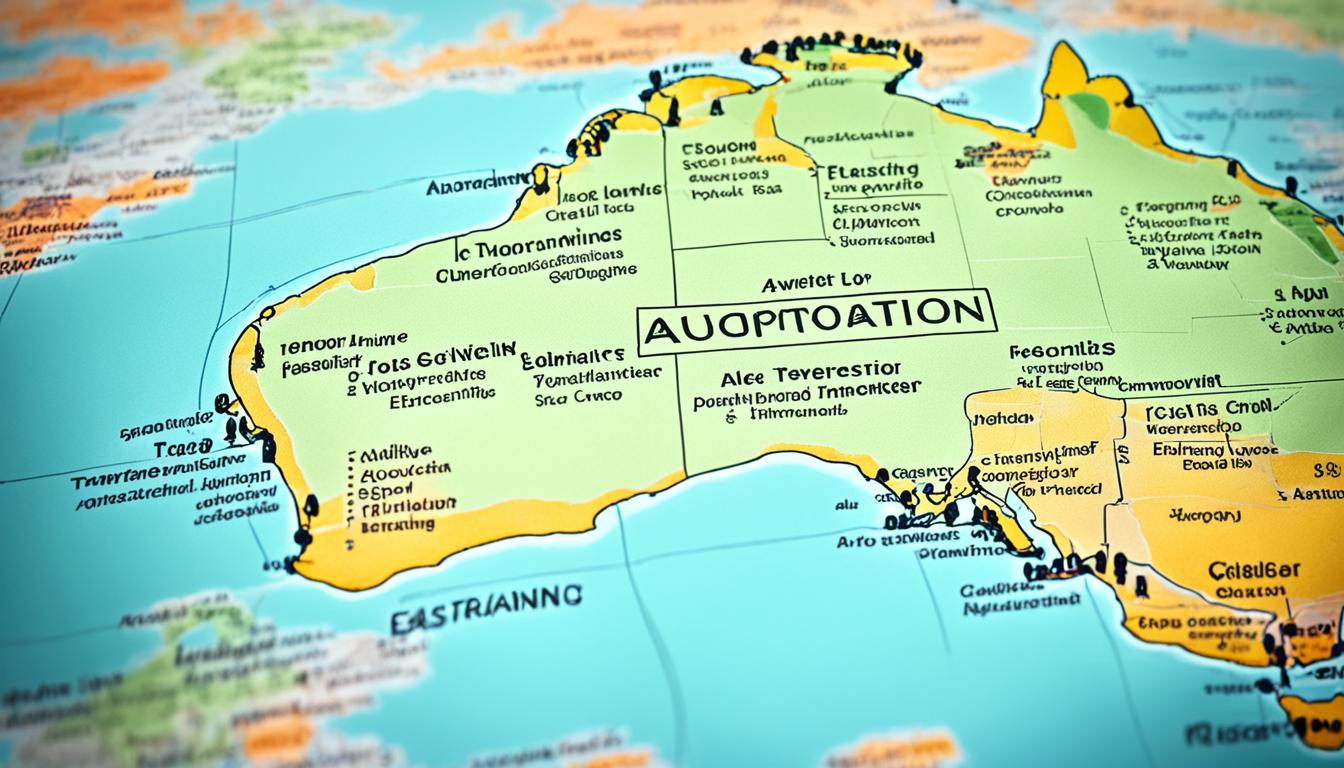
In the world of food safety, proper hot food storage is paramount to prevent the risk of foodborne illnesses. Understanding the ideal holding temperatures for hot food and implementing proper storage practices is crucial for maintaining food quality and ensuring the safety of your customers.
So, at what temperature should hot food be held? Let’s delve into the topic and explore the food safety guidelines that govern hot food storage. By following these guidelines, you can protect your customers and establish a reputation for excellence in food quality and safety.
Key Takeaways:
- Safe hot food storage requires maintaining proper holding temperatures.
- Following food safety guidelines is critical to prevent foodborne illnesses.
- Proper food storage practices help maintain food quality and safety.
- Knowing the temperature danger zone is essential to prevent bacterial growth.
- Monitoring and controlling holding temperatures ensure food safety.
Understanding the Temperature Danger Zone
In order to prevent foodborne illnesses, it is crucial to have a clear understanding of the temperature danger zone. The temperature danger zone refers to the range of temperatures in which bacteria can rapidly grow in food, posing a significant risk to human health. By maintaining proper temperatures, you can minimize the risk of foodborne illnesses and ensure the safety of the food you consume.
Let’s delve into the specific temperature range of the danger zone and why it is important to prevent food from staying within this zone. The temperature danger zone typically ranges from 40°F (4°C) to 140°F (60°C). Within this range, microorganisms such as bacteria can multiply rapidly, doubling in number every 20 minutes. This rapid bacterial growth can result in the production of toxins that can cause food poisoning or other foodborne illnesses.
Preventing food from entering and staying within the temperature danger zone is critical to food safety.
Proper temperature control is especially important for hot food items, as they may be susceptible to entering the danger zone if not handled correctly. Hot foods should be held at a minimum temperature of 140°F (60°C) or above to prevent bacterial growth. Similarly, cold food items should be stored below 40°F (4°C) to inhibit the growth of harmful bacteria.
| Food Category | Safe Holding Temperature (°F) |
|---|---|
| Hot Foods | 140°F (60°C) or above |
| Cold Foods | Below 40°F (4°C) |
Avoiding the temperature danger zone requires implementing proper temperature control measures at all stages of food storage, preparation, and service. Regularly monitoring and recording temperatures, using thermometers, and maintaining heating or cooling equipment are essential practices to ensure food safety. By following these guidelines, you can significantly reduce the risk of foodborne illnesses and protect the health of yourself and others.
Understanding the temperature danger zone is vital to ensuring the safety of the food you consume. By staying vigilant and implementing proper temperature control measures, you can minimize the risk of foodborne illnesses and keep yourself and others safe.
Safe Holding Temperatures for Hot Food
Ensuring the safe handling of hot food is paramount to maintaining food safety and preventing the growth of harmful bacteria. One key aspect of safe food handling practices is maintaining appropriate holding temperatures for hot food. Different types of hot food have specific temperature requirements to ensure their freshness and safety.
Here are the recommended safe holding temperatures for common types of hot food:
| Food Type | Safe Holding Temperature Range (°F) |
|---|---|
| Soups and stews | 135 – 165 |
| Poultry (including chicken and turkey) | 165 – 175 |
| Seafood (including fish and shellfish) | 145 – 155 |
| Beef and pork | 145 – 160 |
| Vegetables | 135 – 145 |
| Rice and grains | 135 – 145 |
It is essential to adhere to these temperature ranges to ensure that hot food remains safe for consumption. Failure to maintain proper holding temperatures can lead to bacterial growth, increasing the risk of foodborne illnesses.
Proper temperature control measures should be implemented to uphold food safety standards. This includes using appropriate equipment, such as hot holding cabinets and heating lamps, to maintain the recommended temperatures. Regular monitoring of temperatures, using reliable thermometers, is vital to ensure consistent compliance with safe holding temperature requirements.
Remember, safe food handling practices are crucial throughout the entire food service process. By maintaining proper holding temperatures for hot food, you can safeguard against the growth of harmful bacteria and provide your customers with safe and enjoyable dining experiences.
Importance of Proper Food Handling
Proper food handling is of utmost importance when it comes to maintaining food safety. Following food protection regulations and implementing safe food handling practices ensures that hot food is stored and served at the appropriate temperatures, reducing the risk of foodborne illnesses.
Food protection regulations are in place to safeguard public health and prevent the spread of foodborne pathogens. These regulations outline specific guidelines and requirements for storing, handling, and serving food safely. By adhering to these regulations, businesses can create a safe and hygienic environment for both customers and employees.
In addition to complying with food protection regulations, incorporating safe food handling practices is essential. This includes practices such as proper handwashing, using gloves and utensils, maintaining a clean and sanitized workspace, and preventing cross-contamination. Implementing these practices helps minimize the risk of foodborne illnesses caused by bacterial contamination.
“Safe food handling practices are not only crucial for preventing foodborne illnesses but also for protecting the reputation and credibility of your establishment. By prioritizing food safety, you demonstrate your commitment to providing high-quality, safe meals to your customers.”
To emphasize the importance of proper food handling, let’s take a look at a table that highlights some key safe food handling practices and their significance:
| Safe Food Handling Practices | Significance |
|---|---|
| Proper handwashing | Prevents the spread of bacteria and viruses from hands to food |
| Using gloves and utensils | Reduces the risk of contamination and improves food safety |
| Maintaining a clean workspace | Prevents cross-contamination and ensures hygienic food preparation |
| Preventing cross-contamination | Minimizes the transfer of bacteria from one food item to another |
By implementing these safe food handling practices and adhering to food protection regulations, you can create a safe environment for both customers and employees, minimize the risk of foodborne illnesses, and protect the reputation and credibility of your establishment.
Factors Affecting Hot Food Holding Temperatures
Proper temperature control measures are essential for safe food storage and preventing the growth of harmful bacteria. Various factors can impact the holding temperatures of hot food, affecting both its quality and safety. In this section, we will explore these factors and discuss their significance in maintaining optimal hot food storage conditions.
Equipment Used for Holding Food
The type and quality of equipment used for holding hot food play a crucial role in maintaining the desired temperatures. Insulated holding cabinets, hot-holding drawers, and steam tables are commonly used to preserve heat and ensure that food stays within a safe temperature range. These equipment options provide effective insulation while allowing easy access to food for service.
Ambient Temperature
The ambient temperature of the environment in which hot food is stored can greatly impact its holding temperatures. In warm or hot climates, it becomes even more essential to use suitable holding equipment to compensate for the higher ambient temperatures. Proper insulation and temperature control mechanisms help counteract the external heat and maintain the integrity of the hot food.
Insulation Methods
Another crucial aspect of hot food storage is the insulation method employed. Adequate insulation acts as a barrier to heat loss, minimizing temperature fluctuations within the storage environment. Insulation materials such as double-walled containers, thermal blankets, and foil wraps can help ensure that hot food retains its desired temperature for an extended period, reducing the risk of bacterial growth.
“Proper temperature control measures and reliable holding equipment are vital to prevent bacterial growth and maintain safe hot food storage.”
Understanding the factors that influence hot food holding temperatures is essential for ensuring compliance with safe food storage requirements. By utilizing suitable equipment, monitoring ambient temperature, and implementing effective insulation methods, you can maintain optimal temperature control measures, safeguarding the quality and safety of your hot food.

Factors Affecting Hot Food Holding Temperatures
| Factors | Impact |
|---|---|
| Equipment Used for Holding Food | Determines the efficiency of heat preservation and temperature control during storage. |
| Ambient Temperature | Affects hot food holding temperatures, particularly in warm or hot environments. |
| Insulation Methods | Helps maintain steady temperatures and minimize heat loss during storage. |
Best Practices for Hot Food Storage
To maintain the quality and safety of your hot food, it is crucial to follow best practices for hot food storage. By implementing proper food storage techniques and safe food handling practices, you can prevent foodborne illnesses and ensure the satisfaction of your customers.
1. Use Appropriate Containers: Choose containers that are specifically designed for hot food storage. These containers should be made of food-grade materials that can withstand high temperatures without leaching harmful chemicals into the food.
2. Label Your Food: Properly label all containers with the name of the food, the date of preparation, and any necessary heating or reheating instructions. This helps you keep track of the freshness of the food and ensures that it is consumed within the recommended timeframe.
3. Practice First-In, First-Out (FIFO): When storing hot food, make sure to rotate and use older items before newer ones. This practice helps prevent food spoilage and reduces the risk of consuming expired food.
4. Maintain Proper Temperatures: Keep hot food at the appropriate holding temperature to prevent bacterial growth. Use appropriate food storage equipment, such as hot food holding cabinets or steam tables, to maintain consistent temperatures.
5. Monitor Food Temperatures: Regularly check the internal temperatures of your hot food using a food thermometer. Ensure that the food is held at the recommended temperature to ensure safety and quality.
6. Train Your Staff: Provide proper training to your staff on safe food handling practices and the importance of proper food storage. This includes training on temperature control, hygiene, and cross-contamination prevention.
7. Implement a Cleaning Schedule: Regularly clean and sanitize all food storage areas, equipment, and utensils to prevent the buildup of harmful bacteria and maintain a clean storage environment.
| Best Practices for Hot Food Storage | |
|---|---|
| Use Appropriate Containers | Choose containers designed for hot food storage |
| Label Your Food | Properly label containers with food details and dates |
| Practice First-In, First-Out (FIFO) | Rotate and use older items before newer ones |
| Maintain Proper Temperatures | Use suitable equipment to maintain consistent temperatures |
| Monitor Food Temperatures | Regularly check internal temperatures with a food thermometer |
| Train Your Staff | Provide training on safe food handling practices |
| Implement a Cleaning Schedule | Regularly clean and sanitize storage areas and equipment |
Following these best practices will help ensure that your hot food remains fresh, safe, and of the highest quality. By prioritizing proper food storage and safe handling practices, you can protect your customers’ health and maintain a reputable establishment.
Recommended Serving Temperature Standards
When it comes to hot food, serving it at the right temperature is crucial for both food quality and safety. Serving hot food at the appropriate temperature ensures that it is enjoyable to eat and minimizes the risk of foodborne illnesses caused by bacteria growth. To help you understand the recommended serving temperature standards, here are some guidelines for various types of hot food:
Serving Temperature Standards
| Food Item | Recommended Serving Temperature |
|---|---|
| Soups and stews | 140°F (60°C) or above |
| Grilled meats | 145°F (63°C) or above |
| Roasted poultry | 165°F (74°C) or above |
| Casseroles | 160°F (71°C) or above |
| Hot side dishes | 140°F (60°C) or above |
| Hot beverages | 160°F (71°C) or above |
These serving temperature standards are based on food safety guidelines and are designed to ensure that hot food reaches a temperature that kills harmful bacteria. By following these standards, you can minimize the risk of foodborne illnesses and provide your customers with safe and enjoyable hot food.
Always remember to use food thermometers to check the internal temperature of hot food before serving. Properly trained staff and safe food handling practices are essential to maintain these temperature standards and ensure the safety of your customers.
“Serving hot food at the recommended temperatures is not just about quality and taste, but it is also a crucial step in ensuring food safety and protecting your customers.”
Monitoring and Controlling Holding Temperatures
When it comes to safe hot food storage, monitoring and controlling holding temperatures are crucial to prevent bacterial growth and maintain food safety. By implementing temperature control measures and following safe food storage requirements, you can ensure that your hot food stays within the appropriate temperature range.
There are several methods and tools available for effectively monitoring and controlling holding temperatures:
- Thermometers: Regular temperature checks using calibrated thermometers is essential to verify that hot food is being stored at safe temperatures. Place thermometers in different areas of your storage units to ensure accurate temperature readings.
- Temperature Logs: Maintaining temperature logs allows you to track and document the temperatures of your hot food storage over time. This helps identify any patterns or fluctuations and enables you to take corrective actions if necessary.
In addition to temperature monitoring, it is crucial to have strategies in place for corrective actions if temperatures deviate from safe ranges. This could include:
1. Adjusting equipment settings: If temperatures are consistently too high or too low, check if your equipment settings need to be adjusted or recalibrated.
2. Investigating and rectifying issues: If there are fluctuations in holding temperatures, investigate the root cause and take appropriate steps to rectify the issue. This may involve inspecting equipment, checking seals on storage units, or addressing any environmental factors affecting temperature control.
3. Discarding unsafe food: If you find that hot food has been stored at unsafe temperatures for an extended period, it is crucial to discard it to prevent the risk of foodborne illnesses.
Remember, maintaining safe holding temperatures is essential to food safety. By regularly monitoring temperatures, keeping detailed temperature logs, and taking corrective actions when necessary, you can ensure that your hot food storage meets the necessary safety standards.
| Temperature Control Measures | Benefits |
|---|---|
| Regular temperature checks using calibrated thermometers | Ensures accurate monitoring of hot food storage temperatures |
| Maintaining temperature logs | Tracks temperature patterns and enables corrective actions |
| Adjusting equipment settings | Allows for precise control of storage unit temperatures |
| Investigating and rectifying issues | Addresses potential causes of temperature fluctuations |
| Discarding unsafe food | Prevents the risk of foodborne illnesses |
Employee Training and Education
Ensuring that employees receive proper training and education on food safety guidelines and safe food handling practices is vital. By equipping your staff with the necessary knowledge and skills, you can significantly reduce the risk of foodborne illnesses and enhance the overall safety of hot food storage and handling.
Implementing comprehensive training programs should be a priority for every food establishment. These programs should cover a wide range of topics, including:
- The importance of proper food storage and handling
- Safe temperature control measures
- Hygiene practices and personal protective equipment (PPE)
- Cross-contamination prevention
- Proper cleaning and sanitization procedures
Training sessions should be conducted regularly to keep employees informed and up-to-date with the latest food safety guidelines. This ensures that they understand the importance of following safe practices in their daily tasks and can identify potential risks and take appropriate action.
Employee accountability is crucial for maintaining a culture of food safety. All staff members should be held responsible for their actions and adherence to proper food handling practices. Implementing performance evaluations and incorporating food safety metrics into employee assessments can help reinforce the importance of safe food handling and encourage accountability.
Regular refreshers are also essential to reinforce knowledge and ensure that employees stay informed about any updates or changes to food safety guidelines. This can be done through periodic training sessions, educational materials, and reminders in the workplace.
“Investing in employee training and education is an investment in the safety and reputation of your establishment. By empowering your staff with the knowledge and skills needed to handle hot food safely, you are protecting both your customers and your business.”
The Benefits of Employee Training and Education
Proper training and education on food safety guidelines and safe food handling practices offer several important benefits:
- Reduces the risk of foodborne illnesses: When employees are well-trained and follow safe practices, the likelihood of contamination and foodborne illnesses is significantly reduced.
- Enhances customer trust: By demonstrating a commitment to food safety, you instill confidence in your customers that they are being served safe and hygienic food.
- Protects your establishment’s reputation: A single foodborne illness incident can have severe consequences for your business’s reputation. Well-trained employees help prevent such incidents and maintain a positive image.
- Ensures compliance with regulations: Proper training ensures that your establishment meets the food safety standards set by regulatory authorities, preventing potential fines or legal issues.
- Improves overall efficiency: Knowledgeable employees can carry out their tasks more effectively, reducing mistakes, waste, and operational inefficiencies.
To emphasize the importance of employee training and education in hot food storage and handling, here is a visually engaging table summarizing the benefits:
| Benefits of Employee Training and Education |
|---|
| Reduces the risk of foodborne illnesses |
| Enhances customer trust |
| Protects your establishment’s reputation |
| Ensures compliance with regulations |
| Improves overall efficiency |

Common Mistakes to Avoid
When it comes to hot food storage, avoiding common mistakes is essential to prevent potential foodborne illnesses and maintain the quality of your food. By being aware of these mistakes and taking proactive measures to avoid them, you can ensure food safety and protect the well-being of your customers.
1. Improper Temperature Control
One of the most critical mistakes in hot food storage is improper temperature control. Failing to monitor and maintain the correct temperature can lead to bacterial growth and foodborne illnesses. Avoid this mistake by:
- Regularly checking and calibrating temperature monitoring devices, such as thermometers.
- Training your staff on proper temperature control practices and emphasizing the importance of accurate temperature measurement.
- Using insulated containers or hot holding equipment to maintain the appropriate temperature for hot food.
2. Inadequate Food Rotation
Inadequate food rotation can result in the storage of expired or spoiled food, which poses a risk to food safety. To avoid this mistake:
- Implement a first-in, first-out (FIFO) system to ensure the use of older food items before newer ones.
- Regularly inspect food items for signs of spoilage, such as unusual odors or changes in color or texture.
- Create a clear labeling system to indicate the date of preparation or expiration for each food item.
3. Poor Sanitation Practices
Ignoring proper sanitation practices can compromise food safety and lead to contamination. To maintain sanitation in hot food storage:
- Regularly clean and sanitize storage areas, including shelves, containers, and equipment.
- Train your staff on proper handwashing techniques and enforce strict hygiene practices in the storage area.
- Avoid storing cleaning chemicals near food storage areas to prevent cross-contamination.
4. Failure to Follow Food Safety Guidelines
Not adhering to food safety guidelines increases the risk of foodborne illnesses. To ensure compliance and minimize mistakes:
- Stay updated on food safety regulations and regularly review them with your staff.
- Provide comprehensive training on proper food handling, storage, and sanitation practices.
- Establish a culture of accountability where employees understand the importance of following food safety protocols.
5. Inadequate Staff Training
Insufficient training can lead to misunderstandings and mistakes in hot food storage. It is crucial to invest in proper staff training:
- Provide comprehensive training programs that cover all aspects of hot food storage, including temperature control, sanitation, and proper handling techniques.
- Regularly refresh and update training materials to ensure your staff are aware of the latest food safety guidelines.
- Hold regular workshops and evaluations to assess your employees’ knowledge and skills in hot food storage.
Remember, implementing proper food storage practices is key to preventing foodborne illnesses and maintaining the quality of your hot food. By avoiding these common mistakes and establishing a robust food safety system, you can ensure the health and satisfaction of your customers.
Compliance with Food Protection Regulations
In the realm of hot food storage and handling, compliance with food protection regulations is paramount. These regulations are established to safeguard public health and maintain the highest standards of food safety. By ensuring strict adherence to these regulations, businesses can create a secure environment for storing and handling hot food.
Safe food storage requirements, outlined in food protection regulations, encompass various aspects such as temperature control, hygiene practices, and proper handling techniques. These regulations are designed to prevent the growth of harmful bacteria, minimize the risk of foodborne illnesses, and safeguard the well-being of customers.
Meeting these regulations involves understanding and implementing the guidelines provided by organizations dedicated to food safety, such as the U.S. Food and Drug Administration (FDA), the U.S. Department of Agriculture (USDA), and local health departments. These guidelines provide businesses with a framework of best practices, ensuring that hot food storage meets the highest safety standards.
Here are some key food protection regulations and requirements that establishments need to adhere to:
- Temperature Control: Proper temperature control is crucial for safe hot food storage. Food protection regulations define specific temperature ranges for holding hot food, which businesses must strictly follow. Failure to comply with these temperature requirements can facilitate bacterial growth and increase the risk of foodborne illnesses.
- Hygiene Practices: Maintaining cleanliness and adopting proper hygiene practices are vital components of food protection regulations. Businesses must ensure that their personnel are well-trained in personal hygiene, including handwashing, wearing appropriate protective gear, and maintaining a clean and sanitized work environment.
- Storage and Labeling: Food protection regulations also encompass storage and labeling requirements. Businesses must store hot food in appropriate containers that can maintain the desired temperatures and prevent cross-contamination. Additionally, accurate and legible labeling is crucial to ensure proper identification, rotation, and traceability of stored food items.
- Inspections and Record-Keeping: Regulatory authorities conduct routine inspections to ensure compliance with food protection regulations. Businesses are required to maintain records of temperature logs, cleaning schedules, employee training, and other relevant documentation. These records serve as evidence of compliance during inspections and audits.
By adhering to food protection regulations, businesses demonstrate their commitment to food safety and communicate trust and reliability to their customers. It is essential to prioritize compliance, not only to uphold legal requirements but also to mitigate potential risks and maintain a stellar reputation.
Failure to Comply: Consequences and Impact
“Non-compliance with food protection regulations can lead to severe consequences, including legal penalties, fines, and reputational damage. More importantly, failure to comply can result in compromised food safety, leading to foodborne illnesses and harm to consumers. It is crucial for businesses to prioritize compliance and adhere to food protection regulations, implementing proactive measures to ensure safe hot food storage and handling.”
Businesses must stay updated on changes in food protection regulations and actively educate their staff on the latest requirements. This includes providing comprehensive training programs, conducting regular refresher courses, and fostering a culture of accountability for food safety.
Next, let’s explore the importance of regular inspections and audits in upholding compliance with food protection regulations and maintaining safe hot food storage practices.
Importance of Regular Inspections and Audits
Regular inspections and audits are crucial in ensuring compliance with food protection regulations and maintaining safe food storage practices. These processes help identify any potential risks or non-compliance issues, allowing establishments to take corrective actions promptly. Moreover, inspections and audits serve as opportunities to assess the effectiveness of existing protocols and make necessary improvements to enhance food safety.
During inspections, regulatory authorities or third-party auditors evaluate various aspects of an establishment’s operations, including hygiene practices, storage conditions, temperature control measures, and employee training. They assess whether food protection regulations and safe food storage requirements are being met and provide guidance on areas that need improvement.
A thorough inspection or audit involves meticulous documentation review, on-site observations, and interviews with staff members. This comprehensive evaluation ensures that establishments are complying with food safety standards and are actively working towards maintaining safe hot food storage.
Implementing regular inspections and audits offers several benefits, including:
- Identifying and addressing potential food safety hazards
- Improving compliance with food protection regulations
- Ensuring safe storage conditions for hot food
- Enhancing customer trust and confidence
- Minimizing the risk of foodborne illnesses
- Providing opportunities for continuous improvement
The Importance of Preparation
Preparing for inspections and audits is crucial to ensure a successful evaluation. Here are some steps you can take to be well-prepared:
- Review food protection regulations: Familiarize yourself with the specific regulations and requirements relevant to your establishment’s operations.
- Implement robust food safety practices: Establish and consistently follow proper food storage protocols, including temperature control measures, labeling, and stock rotation.
- Train your staff: Provide comprehensive training to all employees involved in hot food storage, emphasizing the importance of following food safety guidelines and complying with regulations.
- Maintain accurate documentation: Keep detailed records of temperature logs, cleaning schedules, employee training records, and any corrective actions taken to demonstrate compliance.
- Conduct internal audits: Regularly perform self-assessments to identify any areas of concern and proactively address them before formal inspections or audits.
By prioritizing regular inspections and audits, establishments can ensure the safe storage of hot food, maintain compliance with food protection regulations, and safeguard public health. These processes not only contribute to the prevention of foodborne illnesses but also help establish a reputation for adherence to high standards of food safety and quality.
Emerging Technologies in Hot Food Storage
Advancements in technology have revolutionized the way hot food is stored, ensuring optimal temperature control measures and enhancing proper food storage practices. These emerging technologies offer a range of benefits for food safety, improving efficiency, and minimizing the risk of foodborne illnesses.
One such innovative technology is smart refrigeration systems equipped with temperature monitoring sensors, which provide real-time data on the internal temperature of storage units. This enables continuous monitoring and allows for immediate corrective actions if the temperature deviates from safe ranges.
Additionally, automated inventory management systems with temperature sensors provide accurate data on stock levels and temperature conditions. This helps facilitate better food rotation practices, reducing the risk of serving expired or improperly stored food.
Another emerging technology is the use of blockchain technology to ensure traceability and transparency in the food supply chain. By securely storing temperature data at each stage of the storage and distribution process, blockchain technology allows for better accountability and identification of potential food safety risks.
Infrared heating technology is also gaining traction in hot food storage. This technology uses infrared radiation to evenly heat food, eliminating the need for conventional heating methods that can lead to inconsistent temperatures and food quality degradation. Besides, it reduces energy consumption, making it a more sustainable option.
Ultraviolet (UV) light technology is another breakthrough in hot food storage. UV light has antimicrobial properties and can be used to disinfect storage units, reducing the presence of harmful bacteria. This technology provides an additional layer of protection against cross-contamination and improves food safety.
Benefits of Emerging Technologies in Hot Food Storage:
- Improved temperature control measures
- Enhanced food safety and reduced risk of foodborne illnesses
- Efficient inventory management
- Increased transparency and traceability in the food supply chain
- Consistent heating and better food quality
- Antimicrobial properties for enhanced food storage hygiene
Integrating these emerging technologies into hot food storage practices can significantly improve food safety, minimize wastage, and enhance overall operational efficiency. However, it is important to consider factors such as cost, training requirements, and compatibility with existing infrastructure when adopting these technologies.
Conclusion
In conclusion, the proper storage of hot food at ideal holding temperatures is of paramount importance in preventing foodborne illnesses and ensuring food safety. By adhering to food safety guidelines, employing proper handling techniques, and complying with regulations, you can safeguard your customers’ well-being and maintain exceptional standards of food quality.
By understanding the temperature danger zone and the risks associated with it, you can effectively prevent bacterial growth by ensuring that hot food does not remain within this range for extended periods.
Implementing safe holding temperatures for hot food is crucial. By following recommended temperature ranges for different types of hot food, you can inhibit bacterial growth and protect against potential foodborne pathogens.
Remember, maintaining the integrity of hot food depends on a range of factors, including equipment used for holding, ambient temperature, and insulation methods. By controlling these factors, you can guarantee that hot food is stored at the right temperatures, minimizing the risk of foodborne illnesses.







